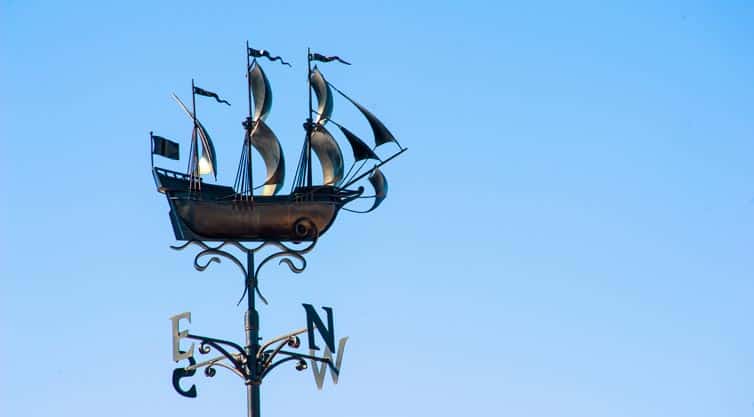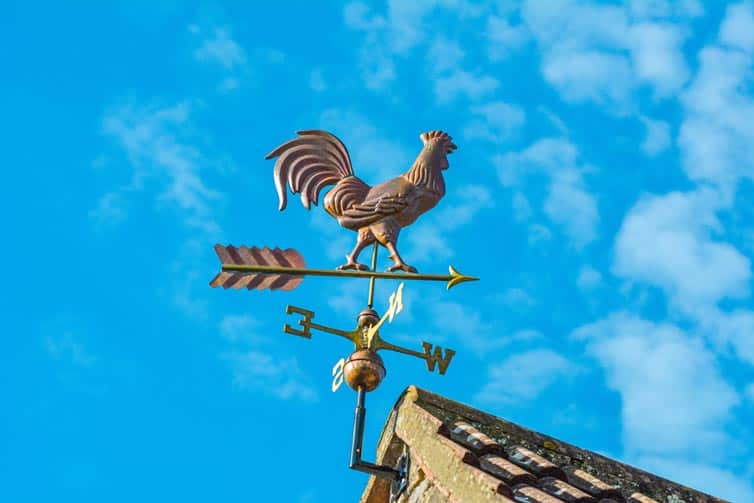The ability to forecast the weather has been, and continues to be, important for a variety of reasons. Today, satellites, computers, and advanced technology make it simple to predict weather conditions. In the past, however, people did not have the benefit of this technology and had to turn to other means of predicting what the weather would bring. To do that, people depended on a much simpler form of technology called weather vanes. Weather vanes are relatively simple devices that are used to show the direction of the wind. Although they are predominantly used for decorative purposes in modern society, they do have an interesting and lengthy history as a functional instrument that performed a very important service.
The History of Weather Vanes
Weather vanes are far from being a modern technology. Their history dates back centuries, with the first recorded evidence of a weather vane going back to 48 B.C. It is believed that this device was built by an astronomer named Andronicus and may have been up to six feet long. It was placed on the Tower of the Winds in Athens in honor of Triton, a Greek god.
In ancient times weather vanes often depicted Greek or Roman gods such as Mercury, Hermes, and Boreas. Vikings also used weather vanes on their ships. Fabric was used to monitor the wind during medieval times, when archers would watch the flapping of flags.
European churches began to put weather vanes with roosters on churches during the 9th century A.D. at the behest of the pope. Roosters became a common feature of weather vanes in America and Europe, and their large tails were well-suited for catching the wind, too. In the United States, a notable weather vane was commissioned by George Washington. It was called “Dove of Peace” and was meant to commemorate the ending of the Revolutionary War. This weather vane was made by Joseph Rakestraw in 1787, and it featured the dove of peace with an olive branch in its beak. Washington had the weather vane installed on the cupola at the top of Mount Vernon. This weather vane is still sitting on Mount Vernon today.
In European communities, there may have just been a single weather vane sitting on the highest building. All the people in the community used the same weather vane because they lived close to each other in a small area. People in the United States tended to be more spread out without clusters of communities. So, every farm and homestead often had a weather vane sitting atop the barn.
How Weather Vanes Work
Farmers relied on weather vanes to help them anticipate the weather. Colder air is usually located in the north and warmer is in the south. So, a weather vane showing a north wind would indicate that colder air is moving in, which could also be a sign that a cold front has passed through an area.
When researching weather vanes, one will frequently encounter the term “wind vane.” Wind vanes and weather vanes perform the same task of showing the direction of the wind. These devices are traditionally placed high on top of structures such as barns or churches. They are mounted in locations that are up high so that they are a good distance away from anything that can create a false wind, such as machinery, cars driving by, aircraft, or other man-made sources that can stir up the air. They are a relatively simple device to make, although care must be taken for accurate results.
Weather or wind vanes are made so that they are an ornament atop a rotating rod. The rotating rod is situated on a fixed rod. Some weather vanes may have directionals or symbols that denote north, south, east, and west or simply north and south. The directionals typically are attached to the fixed rod. The ornament is located near the top of the weather vane and is situated on the rotating rod. The ornament must be made so that it is of equal mass on both sides of the rod; however, the ornament must have one side that is shorter and smaller than the other.

Typically, one end of the ornament is shaped like a pointer or arrow or it comes to some form of point. On the other end of the ornament, it will be wider. When the wind blows, the pointed end is the part that turns into the wind, while the opposite, wider part is caught by the breeze. The blowing wind causes the ornament to pivot, causing the pointed end to point in the direction of the wind. This means if the wind is blowing from the north, the arrow will point north.
Styles of Weather Vanes
There are many different styles when it comes to weather or wind vanes. People can use their imaginations in finding the ideal style for them; however, there are some basic styles to consider. One of the more common styles consists of an arrow on one end and scrollwork on the opposite wider/longer end. Another version of that style includes an arrow and banner in place of the scrollwork. Some weather vanes use silhouettes of animals, full-bodied ornaments depicting animals, or swell-bodied ornaments. Common animals depicted on weather vanes include horses, roosters, or other birds. Historically, weather vanes were cast from iron, bronze, or zinc; however, today’s hand-made weather vanes typically use aluminum, which is lighter than the previously mentioned materials. Machine- or mold-crafted weather vanes are often made using copper.
Modern Weather Vanes
Modern weather vanes may just have a directional pointer that shows the direction the wind is blowing. These weather vanes may also feature an anemometer, which measures wind speed. Having a weather vane and an anemometer on the same device provides more information that can be used to report current weather conditions and predict future weather.



